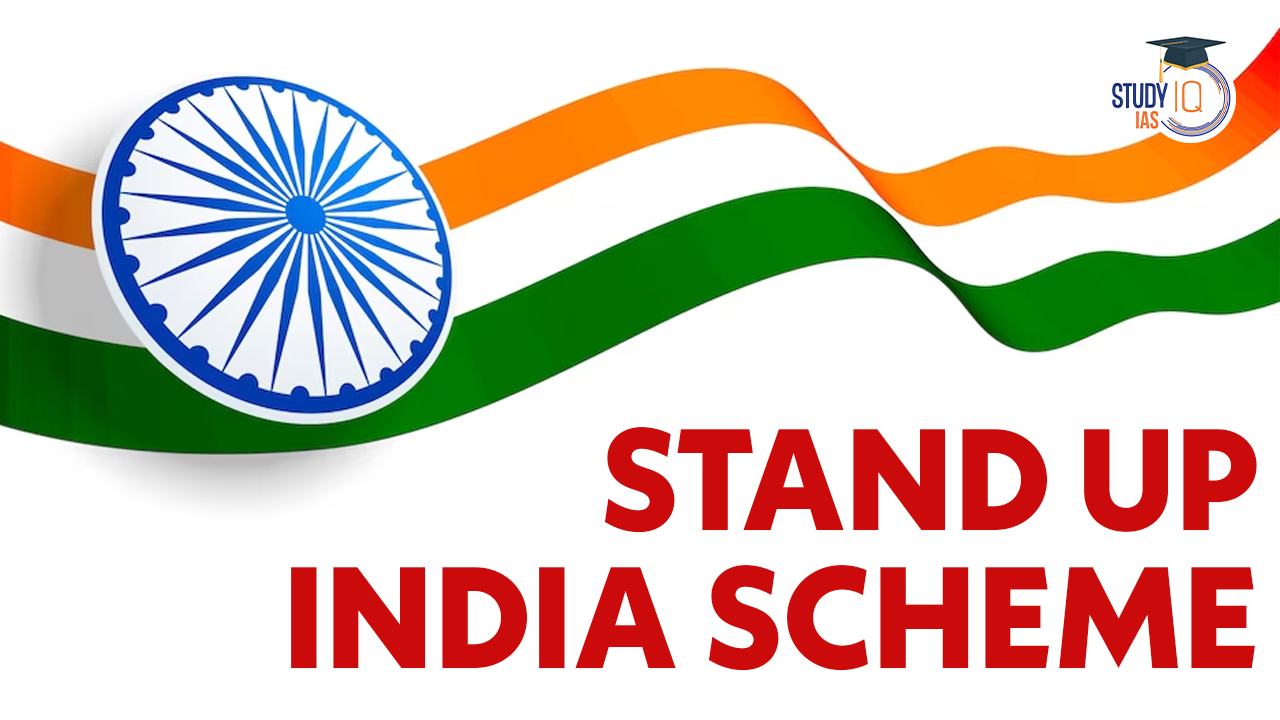Table of Contents
Stand Up India Scheme
In a nation as diverse as India, fostering economic growth and inclusivity is a priority. Stand Up India Scheme, launched in 2016, is designed to foster entrepreneurship and economic empowerment at the grassroots level while generating employment opportunities. This program specifically targets individuals from marginalized communities, including Scheduled Castes (SCs), Scheduled Tribes (STs), and women. This article delves into the key aspects of the Stand Up India Scheme, its objectives, eligibility criteria, and how it empowers aspiring entrepreneurs.
Stand Up India Scheme Overview
The Stand Up India Scheme, initiated by the Ministry of Finance on April 5, 2016, aims to stimulate entrepreneurship at the grassroots level with a specific focus on bolstering economic empowerment and fostering job creation. Notably, this scheme has recently been extended, now set to continue its operations until the year 2025.
| Launch Date | April 5, 2016 |
| Objective | Promote entrepreneurship, economic empowerment, and job creation at the grassroots level. |
| Extended Until | 2025 |
| Target Beneficiaries | · Scheduled Castes (SCs)
· Scheduled Tribes (STs) · Women entrepreneurs |
| Loan Range | Rs. 10 lakh to Rs. 1 crore |
| Project Type | Greenfield projects (start-ups) |
| Implementing Ministry | Ministry of Finance |
| Coverage | Over 1.25 lakh bank branches nationwide |
| Key Features | – Focus on inclusive growth
– Support for marginalized communities – Encourages entrepreneurship from scratch (Greenfield projects) |
Stand Up India Scheme Objective
The Stand-Up India scheme’s primary objective is to enable bank loans ranging from 10 lakh to 1 Crore for the establishment of new ventures, particularly Greenfield enterprises. This program seeks to ensure that each bank branch supports a minimum of one borrower from the Scheduled Caste (SC) or Scheduled Tribe (ST) category and one woman borrower.
These enterprises can operate in various sectors, including manufacturing, services, Agri-allied activities, or trading. In instances involving non-individual enterprises, it’s essential that either an SC/ST or a woman entrepreneur holds at least 51% of the shareholding and has a controlling stake in the venture.
Stand Up India Scheme Features
The Stand Up India scheme, a vital component of the Department of Financial Services (DFS) initiative under the Ministry of Finance, is designed to stimulate entrepreneurial ventures. It offers loans ranging from Rs. 10 lakhs to Rs. 1 crore, encompassing working capital, for the establishment of new enterprises. Each bank branch is tasked with facilitating two entrepreneurial projects, typically one for individuals from the Scheduled Caste (SC) or Scheduled Tribe (ST) community and one for a woman entrepreneur.
To ensure responsible use of funds, a RuPay debit card is provided for credit withdrawals, and the borrower’s credit history is meticulously maintained to prevent misuse. The scheme also includes a refinance window through the Small Industries Development Bank of India (SIDBI) with an initial fund allocation of Rs. 10,000 crore. Additionally, a corpus of Rs. 5,000 crore for credit guarantees is established through the National Credit Guarantee Trustee Company (NCGTC).
Support is comprehensive, encompassing pre-loan training, loan facilitation, marketing assistance, and more, all accessed through a dedicated web portal for online registration and support services. The primary goal is to enhance the accessibility of institutional credit structures for marginalized populations in the non-farm sector while complementing existing government initiatives.
The Small Industries Development Bank of India (SIDBI) will lead the Stand Up India scheme, collaborating closely with the Dalit Indian Chamber of Commerce and Industry (DICCI) and other sector-specific institutions. The designation, as Stand Up Connect Centres (SUCC), will be conferred upon SIDBI and the National Bank of Agriculture and Rural Development (NABARD), with an initial funding injection of Rs. 10,000 crores to bolster financial aid.
The scheme encompasses both a pre-loan and an operational phase, and dedicated officials are on hand to guide and support applicants throughout these stages. Margin money for composite loans can cover up to 25 percent to aid entrepreneurs. Additionally, applicants will receive guidance in leveraging online platforms, e-marketing, web entrepreneurship, factoring services, and registration resources to further their ventures.
Stand Up India Scheme Eligibility
Eligibility for the scheme extends to individuals who are SC/ST and/or women entrepreneurs, aged 18 years or above. The scheme exclusively caters to Greenfield projects, defined here as the beneficiary’s inaugural venture in manufacturing, services, trading, or agriculture-related activities.
For non-individual enterprises, a pivotal requirement is that a minimum of 51% of the shareholding and controlling stake must be held by SC/ST and/or women entrepreneurs. Prospective borrowers must have a clean record, devoid of defaults to any bank or financial institution.
The scheme incorporates a provision for ‘up to 15%’ margin money, which can be combined with eligible Central/State schemes for enhanced support. Regardless, applicants are obligated to contribute a minimum of 10% of the project cost as their own contribution.
Documents Needed for the Stand-Up India Loan Scheme
- A completed application form, accompanied by recent passport-sized photographs.
- Proof of Identity: This can be provided through a driving license, passport, Aadhaar card, Voter’s ID, or PAN Card.
- Proof of Residence: Valid documents include an Aadhaar card, PAN Card, electricity bill, or phone bill.
Stand-Up India Scheme Loan Details
The Stand Up India Scheme offers composite loans ranging from 10 lahks to 100 lahks, covering both term loans and working capital. It primarily aims to facilitate new enterprise creation in manufacturing, trading, or services, with a focus on empowering SC/ST and women entrepreneurs.
While the loan typically covers 75% of the project cost, this requirement may be waived if the borrower contributes over 25% with support from other schemes. Interest rates are based on the bank’s specific rating category, capped at the base rate (MCLR) + 3% + tenor premium.
Security options include primary security, collateral security, or a guarantee from the Credit Guarantee Fund Scheme for Stand-Up India Loans (CGFSIL), determined by the bank. Repayment spans 7 years, with an 18-month maximum moratorium period.
For working capital up to 10 lakh, an overdraft facility with a RuPay debit card is available. If the requirement exceeds 10 lakh, it can be sanctioned as a Cash Credit limit. The scheme allows for up to 15% margin money, which can be coordinated with eligible Central/State schemes. Borrowers are expected to contribute a minimum of 10% of the project cost as their own investment.
Stand Up India Scheme Benefits
Benefits of the Stand Up India Scheme include:
- Employment Generation: The scheme aims to reduce unemployment by encouraging and supporting new entrepreneurs.
- Professional Assistance: It provides investors with professional guidance, time, knowledge about laws, and startup assistance for the initial two years.
- Post-Setup Support: Consultants receive post-setup aid, ensuring ongoing assistance.
- Flexible Repayment: Borrowers have seven years to repay the loan, reducing repayment stress, with annual payments as per their choice.
- Overcoming Obstacles: It helps entrepreneurs overcome legal, operational, and institutional obstacles.
- Socio-economic Empowerment: Promotes job creation and socio-economic empowerment for Dalits, tribals, and women.
- Complementary Schemes: Acts as a catalyst for other government initiatives like ‘Skill India’ and ‘Make in India.’
- Demographic Dividend: Protects and enhances India’s demographic dividend.
- Financial Inclusion: Enhances financial and social inclusion through bank access and technological education.
Stand Up India Scheme Challenges
Challenges of the Stand Up India Scheme include:
- Awareness Gap: Insufficient public education about the socio-economic opportunities for women and SC/ST entrepreneurs can undermine the scheme’s effectiveness.
- Innovation Evaluation Delay: The evaluation process by the DIPP, which assesses product innovation, may introduce delays and potentially deter promising entrepreneurs.
- Turnover Requirement Hurdle: The stipulation of a 25 crore turnover criterion makes it challenging for many prospective entrepreneurs, especially from the SC/ST and women segments, to access financial benefits.
- Sectoral Limitation vs. Loan Range: While the scheme is limited to trading, manufacturing, and services, the loan range of 10 lakhs to 1 crore may not adequately support manufacturing startups.
- Skills and Technology Gap: Some individuals within the women and SC/ST communities may lack exposure to essential skills and technology, hindering their ability to pursue entrepreneurial opportunities.
- Lack of Institutional Solutions: The scheme lacks clear institutional measures to address and overcome these challenges effectively.
Stand-Up India Scheme Achievements
The Stand-Up India scheme has achieved remarkable success in delivering financial support and aid to its intended communities. This has led to the emergence of new job prospects, businesses, and industries. Since its inception, as of March 21, 2023, the scheme has sanctioned an impressive sum of 40,710 crore across 180,636 accounts.
Notably, a substantial portion of these loans, exceeding 80%, has been extended to women entrepreneurs, underscoring the scheme’s dedication to promoting gender inclusivity in entrepreneurship.
Stand Up India Scheme UPSC
The Stand Up India Scheme, launched in 2016, serves as a government initiative to foster entrepreneurship, stimulate economic empowerment at the grassroots level, and create job opportunities. This scheme extends loans ranging from Rs.10 lakh to Rs.1 crore exclusively for Greenfield projects. It is designed to benefit individuals aged 18 and above, specifically from marginalized communities such as Scheduled Castes (SCs), Scheduled Tribes (STs), and women entrepreneurs. With over 1.25 lakh branches across various banks participating, the scheme aims to facilitate access to loans for tribal, Dalit, and women entrepreneurs within their respective service areas. The Stand Up India Scheme underscores the government’s commitment to inclusive growth and economic empowerment, making it a significant topic for UPSC exam preparation.


 National Pest Surveillance System (NPSS)
National Pest Surveillance System (NPSS)
 India launched Operation Brahma for Assi...
India launched Operation Brahma for Assi...
 Old Pension Scheme (OPS) in India and As...
Old Pension Scheme (OPS) in India and As...





















